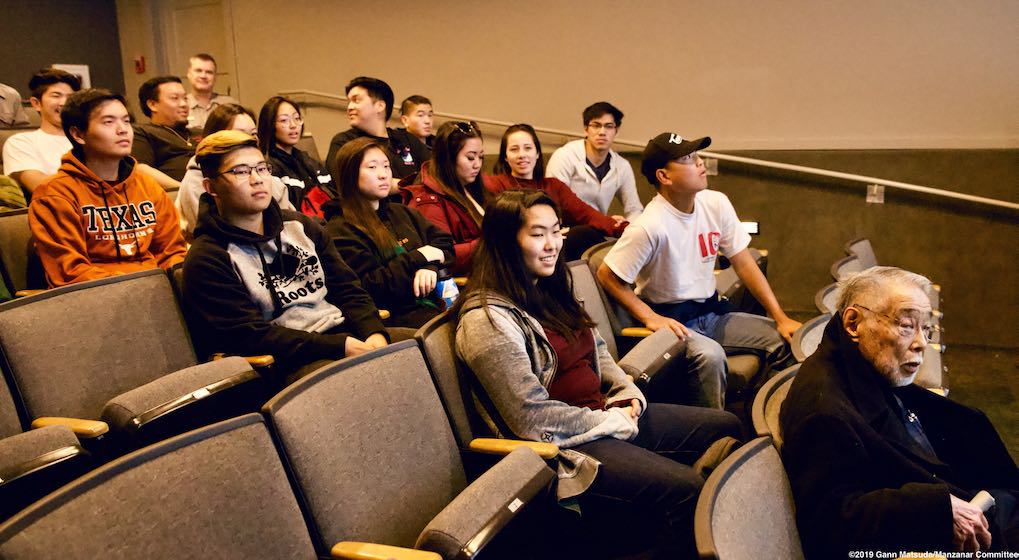We are in the final stretch of publishing reflections from the students who participated in the 2019 edition of Katari: Keeping Japanese American Stories Alive. In this piece, one of our students learned that we are all connected, one way or another.
I have attended the Manzanar Pilgrimage before and I learned a lot from it. However, the Pilgrimage did not go into nearly as much depth as the weekend of the Katari trip to the Manzanar National Historic Site this past November.
The Katari trip delved deeply into the before, during, and after periods of the Japanese American Incarceration. For example, one of the first exercises was learning about anti-Asian sentiment, racist laws, and court cases that that preceded World War II. The exercise showed how the Japanese American Incarceration did not come out of nowhere and instead, was built up over time. Another thing that I learned on the trip was about the people who lived on the land, the Owens Valley Paiute and Shoshone, before they were forcibly removed. Katari highlighted how everyone is connected and that the forced relocation affected, not just the Japanese Americans who were forcibly removed from their homes and communities and incarcerated at Manzanar, but also the people who were removed from the Owens Valley (where Manzanar is located).
The most touching and impactful experience that happened on the Katari trip was interacting with the place and the people who lived there—those who were directly affected by the incarceration. The oral histories were very important in telling the good and bad stories from camp.
The most impressive experience on the trip was being able to talk to people who lived in the incarceration camps. Hearing their stories and asking them questions about their experiences was invaluable. It was important to hear about their experiences before, during, and after camp because it was all connected. The connection between all three time periods showed the lasting impact it had on Japanese Americans, like how families often could not go back to where they came from as they most likely had nothing left. One moment I will never forget from that weekend was seeing Min Tonai, a former Amache incarceree, watch the introductory video shown at the Manzanar National Historic Site, Remembering Manzanar, for the first time. His emotional reaction showed how impactful his time in the camp was to him and how we cannot let something like this happen again.
Throughout my time at the Manzanar National Historic Site, I was in a constant state of reflection. A lot of information was given to us, a majority of it was devastating and it brought a somber mood to the trip. However, there was a more hopeful message that, by speaking up after the incarceration, we were able to preserve the incarceration camps as historic sites. We now use these historic sites to educate others, so these stories are not lost.
It is important for us to advocate for things we are passionate about and to bring attention to various issues. It is important to educate ourselves in order to recognize the past in the present and prevent wrongdoings from happening again in the future. The Katari trip has motivated me to stay updated and politically engaged in order to prevent the past from repeating itself. I am very grateful for this experience and I hope others will have the same or similar opportunities in the future.
The following is a compilation of haikus I wrote based on some of the themes I took away from the Katari trip.
Connecting the Past to the Present
Reflecting on past
connects to present events
We must do better
Resistance
Resist the power
Resist the box we’re placed in
Resist urge to quit
Advocacy
We must speak up now
for people who cannot speak
and tell their stories
Family
Family is the
number one priority
but not in the camps
Peace
Home away from home
Finding peace in the garden
Watch the koi fish swim
Perseverance
Shikata ga nai
We can make the most of it
Gaman is the way
Currently serving as Co-President of the California Polytechnic State University, Pomona Nikkei Student Union, Jordyn Sato is a 20-year-old native of Sunnyvale, California. She is in her third year of study, majoring in Computer Science with a minor in Mathematics. Jordyn also serves on the 2020 Manzanar At Dusk organizing committee.
LEAD PHOTO: Jordyn Sato (foreground center, seated behind Min Tonai (far right) is shown here with fellow students during a presentation at the Manzanar National Historic Site Visitor Center, November 2, 2019. Photo: Gann Matsuda/Manzanar Committee.
 The Manzanar Committee’s Official web site is licensed under a Creative Commons Attribution-NonCommercial-NoDerivs 3.0 Unported License. You may copy, distribute and/or transmit any story or audio content published on this site under the terms of this license, but only if proper attribution is indicated. The full name of the author and a link back to the original article on this site are required. Photographs, graphic images, and other content not specified are subject to additional restrictions. Additional information is available at: Manzanar Committee Official web site – Licensing and Copyright Information.
The Manzanar Committee’s Official web site is licensed under a Creative Commons Attribution-NonCommercial-NoDerivs 3.0 Unported License. You may copy, distribute and/or transmit any story or audio content published on this site under the terms of this license, but only if proper attribution is indicated. The full name of the author and a link back to the original article on this site are required. Photographs, graphic images, and other content not specified are subject to additional restrictions. Additional information is available at: Manzanar Committee Official web site – Licensing and Copyright Information.



Please post your comment on this story below